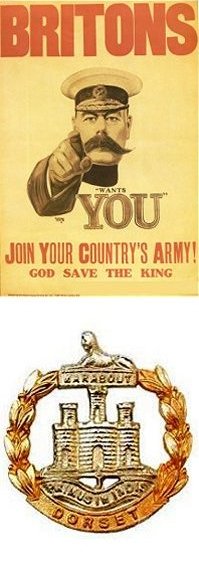yeovil at War
George Albert ricketts
Killed in action in Mesopotamia
George Albert Ricketts was born in Yeovil in 1888, the son of leather dyer John Samuel Ricketts (1868-1900) and Alice née Penny (1869-1922). In the 1891 census John and Alice were listed living at 3 South Place, South Street, with three-year old George and his one-year old sister Beatrice Lily, known as Lily. John Ricketts died in Yeovil in 1900 and in the census the following year Alice was listed as a widow at 4 South Place (a re-numbering? or did she move next door?) with George and Lilly plus her later children Elsie May (b1893), Ethel Rose (b1896) and Amy Maud (b1890). Alice gave her occupation as a leather glover and 13-year old George gave his as a grocer's porter.
 George,
however, was to
become a career
soldier.
Enlisting in
Sherborne, he
became a
Private in the
2nd Battalion,
Dorsetshire
Regiment. His
Service Number
8317 indicates
that he enlisted
in the summer of
1907 at which
time the
Battalion was
stationed in
Madras, India.
George,
however, was to
become a career
soldier.
Enlisting in
Sherborne, he
became a
Private in the
2nd Battalion,
Dorsetshire
Regiment. His
Service Number
8317 indicates
that he enlisted
in the summer of
1907 at which
time the
Battalion was
stationed in
Madras, India.
In the 1911 census George was listed at an undisclosed military establishment somewhere in 'Ceylon and India' but this was, no doubt, in Madras. He was listed as a 23-year old unmarried Private.
In the summer of 1914 George was on home leave, at which time he married Bessie Hoare (1884-1955) at St John's church, Yeovil.
Whether George returned to India or not before the outbreak of war is not known but the 2nd Battalion was in Poona, India, when war broke out and was shipped to Mesopotamia, landing at Fao in the Persian Gulf on 6 November 1914. George may have joined his battalion there.
The 2nd Battalion was trapped in the Siege of Kut al-Amarah (7 December 1915 – 29 April 1916). This was the besieging of a strong British-Indian garrison in the town of Kut al-Amarah, 160 kilometres (100 mi) south of Baghdad, by the Ottoman Army. During the siege at Kut al-Amarah, a composite battalion, composed of returned wounded and other details from the 2nd Dorsets and 2nd Norfolks, was formed at El Orah. It was called the "English Composite Battalion" or the "Norsets" and was under command of the 21st Indian Brigade, 7th (Meerut) Indian Division. Equipped with only one machine gun and manned by inexperienced officers and new recruits, the Norsets were nonetheless put straight into the front line trenches. Two weeks of trench warfare ensued during which time the 2nd Dorsets lost three men killed. In February, further reinforcements for the 2nd Dorsets arrived in the form of 13 officers and 200 men, while another 50 men arrived in March.
They were forced to surrender on 29 April 1916 after 100 days and many of the 2nd Dorsets were captured by the Turks and suffered cruelly in the 'death march' to prisoner of war camps in Turkey. Seventy percent of the 12,500 men who went into captivity died on the march and through subsequent ill treatment. Of the 350 men of the 2nd Dorsets captured, only 70 survived their captivity. The Mesopotamian campaign is remembered for the heat of the desert (120° Fahrenheit was common), the Euphrates valley and the hardship and shameful suffering of many of the wounded.
On 21 July 1916, as a consequence of its losses at Kut al-Amarah, the 2nd Battalion was reconstituted and became Corps Troops in the 3rd Indian Army Corps (Tigris Corps). From September 1916 they were allocated to the Tigris Defences.
On 31 December 1916 George Ricketts was killed in action during the day-to-day fighting in Mesopotamia. He was aged 28 and by the time of his death he had achieved the rank of Staff Sergeant Major. George was commemorated on the now-destroyed Basra Memorial, Iraq, and his name is recorded on the War Memorial in the Borough.
gallery

The Commonwealth War Graves Commission certificate in memory of George Ricketts.